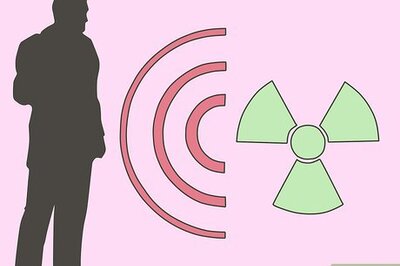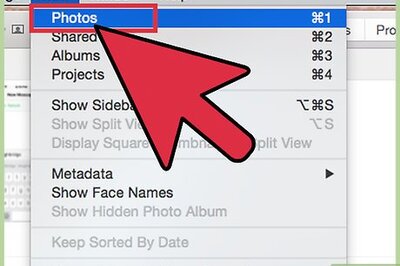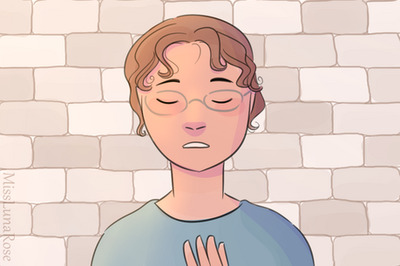
views
How to Pick Out a Good Cantaloupe
Look A perfectly ripe cantaloupe will have a golden-yellow color between the webbing, with tan, beige, and sandy hues as well. If you see greenish hues, that means the cantaloupe is not ripe, so avoid any green-looking cantaloupe! Check out the indentation left by the melon’s stem when it was picked, too—if it dips inward (like an “innie” belly button), that means it’s ripe. Conversely, cantaloupes with a stem scar that isn’t dipping inward probably aren’t ripe. If you see any rough spots on the outside of the cantaloupe, don’t sweat it; they won’t affect its ripeness.
Feel Pick up the cantaloupe and weigh it in your hands; it should feel dense and heavy for its size, and the webbing on its surface should feel fairly thick. Additionally, its rind should feel moderately firm, with just a slight bit of give when you press either end with your thumbs (in other words, firm, but not as hard as a ripe watermelon). If you feel soft spots—or discover that the whole cantaloupe is a little mushy—that means it’s overripe.
Smell Lean in and give the cantaloupe a sniff, right around its blossom end (meaning the end that doesn’t have a depression from where it was attached to the stem). If the cantaloupe is ripe and juicy, it’ll smell sweet and just a little bit musky. If you don’t smell anything at all, it’s unripe—and if you detect a fermented smell, that means it’s overripe.
Sound Gently knock on the cantaloupe (like you’re trying to softly knock on a door). If the knocking produces a low, deep sound, that means it’s ripe! On the other hand, if you hear a more hollow sound from the cantaloupe, that means it’s not quite ripe, and you’re better off choosing another one. If your cantaloupe checks all the boxes outlined here—golden-yellow, an indented stem mark, heavy and thick, fairly firm, sweet-smelling, with a deep sound when knocked, you can be sure it’s ripe!
Will a cantaloupe continue to ripen after picking?
Cantaloupes tend not to ripen much after being picked. So, unfortunately, while an unripe cantaloupe might soften slightly over time, it won’t really sweeten (or taste like a perfectly ripe cantaloupe). Other fruits, like bananas, pears, and plums, will keep ripening after being picked, especially if you leave them out on the counter at room temperature, but cantaloupe won’t taste the same if picked when unripe. You can still leave an unripe cantaloupe for a couple of days to get it to ripen more. It may become a little juicier and softer; just don’t expect it to get any sweeter. That’s why it’s best to pick a cantaloupe that’s at peak ripeness—because there’s no way to ripen it at home!
How to Store Cantaloupe
Let an uncut cantaloupe sit on the counter for 2 to 3 days. If you want to leave a cantaloupe to soften a bit (or you just aren’t ready to cut it up yet), you can simply place it on your counter and let it sit for a couple of days! But if you still aren’t ready to cut it up and eat it after that, you’ll need to stick the cantaloupe in the refrigerator, where it’ll last a bit longer.
Store an uncut cantaloupe in the fridge for up to 5 days. So, if you need your ripe cantaloupe to keep for a little longer, just store it (whole) in the refrigerator. A store-bought cantaloupe will last this way for a few days—but a homegrown, fresh-picked cantaloupe can actually last for up to 2 weeks! Keep in mind that as soon as you cut the cantaloupe, the amount of time you can keep it stored will decrease, so leave it whole if you plan to store it for a while.
Store cut cantaloupe pieces in an airtight container. Once you cut up a cantaloupe, you can store the cut pieces in the refrigerator. However, cut cantaloupe won’t last long, even when stored. Leave the container of cut cantaloupe in the fridge for up to three days—but be sure to eat or use the cantaloupe by then (and know the signs of a cantaloupe gone bad).
What to Do with Unripe Cantaloupe
Combine the cantaloupe with other dishes and recipes. Your unripe cantaloupe may not be ideal for snacking on, but it can still be used. Basically, the name of the here is to get creative! You could cut up your cantaloupe and blend it into a smoothie with other (sweeter) fruits to disguise the unripe edge, for example—or toss the cantaloupe into a salad with dressing. Other ideas include: Make an agua fresca. Blend the cantaloupe with cold water and add a natural sweetener (like honey or agave nectar) to punch it up! Ferment or pickle the cantaloupe. Either process can preserve the melon—and you can still add it to salads, cheese boards, and other recipes. Make jam. Yes, you can turn cantaloupe into jam! And, if you don’t want to use cantaloupe alone, you can add other fruits or flavors to the jam as well.
Bonus: Choosing Ripe Watermelon and Honeydew
Watermelon First things first: a ripe watermelon should have a cream or yellow-colored ground spot—referring to the spot where the melon touched the ground as it grew. Since the ground spot isn’t exposed to sunlight, it won’t be green like the rest of the melon! However, a ground spot that’s white means the watermelon is underripe, and a dark yellow ground spot indicates an overripe watermelon. Shine: The ripe watermelon should actually have a slightly dull look to it (not super shiny and bright). Weight: Ripe watermelons have a higher water concentration (because they’re juicy), so they’ll feel heavy for their size. Try comparing two watermelons of similar size; the heavier one is also the riper one! Sound: When you gently knock on a ripe watermelon, it’ll sound deep and hollow. Still, sound alone isn’t a totally foolproof indicator of ripeness, so use the other tips above too. Size: The size of a watermelon doesn’t actually indicate its ripeness—so check the factors above rather than basing your decision entirely on size!
Honeydew Look for a honeydew melon with a creamy-colored, light yellow rind. It shouldn’t have too much white or green in it! It’s okay if the honeydew also has a few brown spots (it may just taste especially sweet). If you find a ripe-looking honeydew melon, you can also use the following tips to assess it: Texture: Ripe honeydew melons feel slightly tacky, or waxy. From time-to-time, you may also find a ripe honeydew with a net-like texture called “sugar netting” —which actually indicates a lovely flavor! Weight: Any ripe melon, including honeydew, should feel heavy for its size (which indicates that it’s nice and juicy). Sound: Gently knock on your honeydew. If it’s ripe, it’ll sound hollow! You can also give it a shake; if you hear seeds rattling inside, that means the honeydew is overripe.




















Comments
0 comment